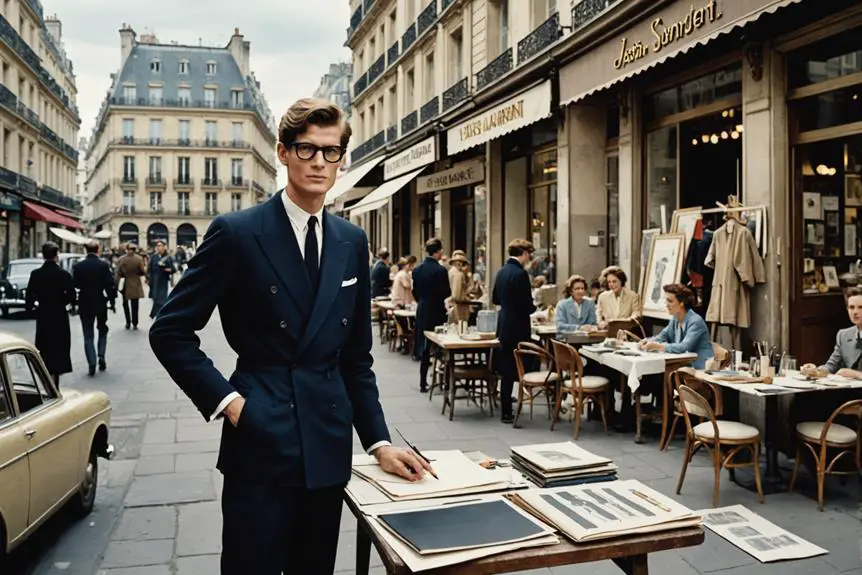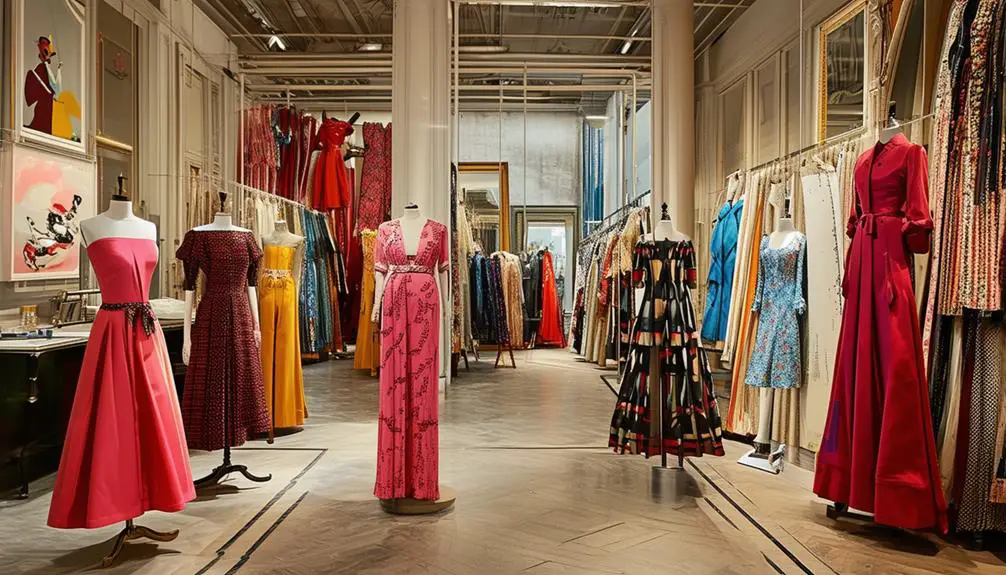Yves Saint Laurent is a fashion brand with a history that is both inspiring and complex. Founded in 1961 by the visionary designer Yves Saint Laurent, the brand quickly rose to prominence in the fashion world. Known for its iconic pieces, such as the women's tuxedo "Le Smoking," the brand challenged gender norms and redefined style. Despite facing personal struggles, Yves Saint Laurent's innovative approach merged art with fashion, leading to the launch of groundbreaking ready-to-wear collections. The brand's legacy transformed the industry, making haute couture more accessible to a broader audience. Today, Yves Saint Laurent continues to thrive under new creative directions, with the influence of its founder's work remaining profound. Discover how this brand has shaped modern fashion and continues to inspire new generations.
Early Life and Background

Yves Saint Laurent's early life, steeped in the cultural richness of Algeria, significantly shaped his future as a fashion icon. Born into a French family on August 1, 1936, he grew up in a Mediterranean villa, where his affluent background provided a nurturing environment for creativity. Surrounded by his two younger sisters, Michèle and Brigitte, Yves developed an early interest in fashion, often creating dresses for family members and designing paper dolls. This hands-on experience ignited a passion that would later define his career as a designer.
During his early teen years, Yves faced challenges, including bullying at his strict Catholic junior high school. These experiences drove him to seek solace in creative pursuits, particularly drawing and costume design. His mother played an essential role in fostering this artistic spirit, encouraging his explorations in fashion and the arts. In addition, regular family outings to the theater and opera enriched his cultural awareness, allowing him to draw inspiration from various artistic forms. By the time he won a prestigious contest at 17, Yves's foundation in fashion and design was firmly established, paving the way for his transformative journey to Paris.
Career Beginnings
With a solid foundation in fashion firmly established, the journey to becoming a leading designer began when Saint Laurent moved to Paris in 1954 at just 17 years old, following his victory in a prestigious fashion design competition. This pivotal move led him to work as an assistant to Christian Dior in 1955, where his designs quickly gained notice among fashion designers. By the age of 21, he ascended to the role of head designer at Dior after the unexpected death of Dior in 1957. During this time, he introduced the revolutionary Trapeze Line, reshaping women's fashion with its innovative silhouette that emphasized elegance and movement.
However, his meteoric rise faced challenges. Drafted into the French army in 1960 during the Algerian War, he experienced mental health issues that led to his dismissal from Dior after hospitalization. Despite this setback, Yves Saint Laurent didn't waver. In 1961, he partnered with Pierre Bergé to establish his own fashion house, where he continued to innovate, creating iconic designs that would cement his legacy in the fashion world.
Iconic Designs and Contributions

Few designers have made as profound an impact on women's fashion as Yves Saint Laurent, whose innovative creations not only challenged societal norms but also redefined the role of women in the fashion industry. One of his most iconic contributions is the women's tuxedo, epitomized by the "Le Smoking" jacket. This design not only defied traditional gender expectations but also empowered women by offering them a sophisticated alternative to conventional attire.
In 1965, his "Mondrian Collection" showcased dresses inspired by the works of Piet Mondrian, exemplifying his unique ability to merge art and fashion seamlessly. With the launch of Rive Gauche in 1966, he democratized fashion by popularizing ready-to-wear, making high fashion accessible to a broader audience.
Saint Laurent's innovative use of sheer fabrics and bold colors, especially seen in his sheer blouses and safari jackets, sparked a fashion revolution during the 1960s and 1970s. His reimagining of the Little Black Dress also solidified his status as a key figure in modern women's wear, leaving an enduring legacy that continues to influence designers today.
Personal Struggles and Resurgence
Throughout his illustrious career, Yves Saint Laurent grappled with significant personal struggles, including addiction and mental health issues that often overshadowed his immense talent. These challenges not only affected his personal life but also influenced his professional output, particularly during the 1980s when he faced criticism for his designs becoming stale. This period led to a phase of reclusiveness and self-doubt, prompting many to question his place in the fashion world.
However, the early 1990s marked a pivotal resurgence for Saint Laurent. You'd notice a renewed interest in his work, as he showcased his ability to innovate despite ongoing personal challenges. His designs gained popularity once more, highlighting his resilience and adaptability.
Key elements during this time included:
- Overcoming addiction and mental health hurdles
- Addressing criticism with renewed creativity
- Embracing innovation in his collections
- Reconnecting with the fashion community
- Leaving a lasting impact on future generations
Yves Saint Laurent's journey through personal struggles exemplifies the complexities of artistic genius, illustrating how resilience can lead to a powerful resurgence while shaping an enduring legacy that continues to influence the fashion industry.
Legacy and Influence

Yves Saint Laurent's legacy is a demonstration of his transformative impact on the fashion industry, redefining not just design but also the cultural landscape of fashion. By popularizing ready-to-wear through his innovative Rive Gauche boutiques, he made high fashion accessible to a broader audience. His groundbreaking Tuxedo Jacket for women challenged traditional gender norms, embracing gender fluidity and influencing contemporary fashion.
Here's a snapshot of his influence:
| Aspect | Contribution | Impact |
|---|---|---|
| Ready-to-Wear | Launched Rive Gauche in 1966 | Democratized high fashion |
| Gender Norms | Introduced the Tuxedo Jacket | Promoted gender fluidity |
| Recognition | First living designer at the Met | Cemented his place in fashion history |
| Ongoing Influence | Brand continues under new designers | Maintains avant-garde aesthetic |
Saint Laurent's work continues to inspire new generations of designers and artists, merging art and fashion with cultural and political themes. His status as a pioneer in the luxury market remains intact, reflecting a legacy that endures through time.
Yves Saint Laurent Today
Continuing to shape the fashion landscape, the Yves Saint Laurent brand thrives today under the creative direction of designers like Hedi Slimane and Anthony Vaccarello. As a luxury fashion house, it maintains its commitment to avant-garde style while appealing to contemporary consumers. The brand's collections embody Saint Laurent's vision of elegance, pushing boundaries in the fashion industry.
Yves Saint Laurent's influence is profound, particularly in areas such as:
- Gender-fluid designs that challenge traditional norms.
- Ready-to-wear collections that prioritize accessibility without compromising style.
- Innovative aesthetics that consistently redefine luxury fashion.
- Personal expression that resonates with a diverse clientele.
- Contributions to arts and culture, showcasing collaborations with artists and engaging in philanthropic efforts.
These elements not only reflect the brand's legacy but also its adaptability in a rapidly changing market. By fostering creativity and inclusivity, Yves Saint Laurent inspires new generations of designers, ensuring its position as a leader in the fashion industry. The brand remains a beacon of innovation and expression, proving that fashion can be both a personal statement and a cultural dialogue.
Frequently Asked Questions
What Is Saint Laurent Brief History?
Saint Laurent revolutionized fashion by introducing ready-to-wear collections and iconic designs like the women's tuxedo. He shifted norms, blending elegance with personal expression, while influencing gender fluidity, leaving an indelible mark on the industry.
What Are Some Interesting Facts About Yves Saint Laurent?
You'll find Yves Saint Laurent revolutionized fashion with the women's tuxedo, "Le Smoking." He pioneered ready-to-wear collections, making haute couture accessible, and drew inspiration from art, particularly his iconic Mondrian collection. His influence persists today.
Why Was Yves Saint Laurent Important?
Yves Saint Laurent's importance lies in his groundbreaking approach to fashion, merging art with clothing, challenging gender norms, and making high fashion accessible. His influence reshaped the industry, encouraging creativity and social commentary throughout subsequent generations.
Why Is It No Longer Called Yves Saint Laurent?
It's no longer called Yves Saint Laurent because the rebranding to "Saint Laurent" aimed to modernize the image, appeal to younger consumers, and reflect contemporary fashion trends, capturing a more casual, rock-and-roll aesthetic.





News on crypto exchanges
Your article helped me a lot, is there any more related content? Thanks!
Your point of view caught my eye and was very interesting. Thanks. I have a question for you. https://www.binance.info/en-IN/register-person?ref=UM6SMJM3
??????? ????????? ????: ????? ????????? ??????
???? ???????.